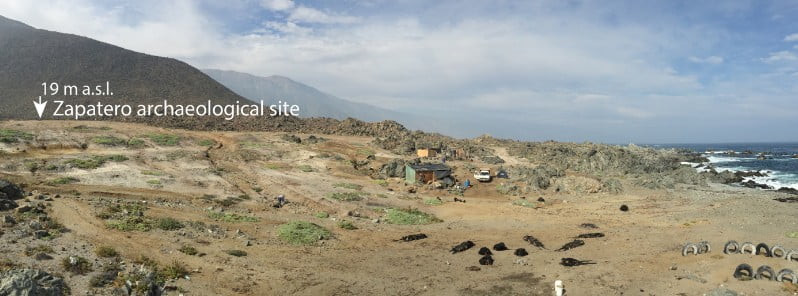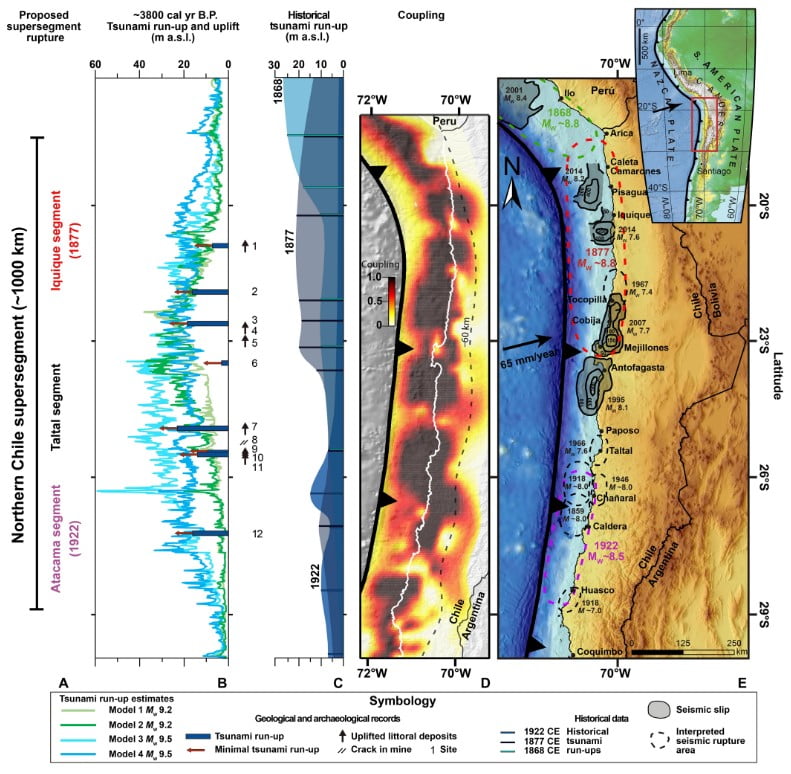Geoarchaeological evidence reveals a major M9.5 tsunamigenic earthquake in Chile

A new study published this week in Science Advances presents geoarchaeological evidence revealing a major M~9.5 tsunamigenic earthquake that severely affected prehistoric hunter-gatherer-fisher communities some 3 800 years ago, causing an exceptional social disruption reflected in contemporary changes in archaeological sites and triggering resilient strategies along these coasts.
- Together with tsunami modeling results, researchers suggest that this event resulted from an approximately 1 000 km (620 miles) long megathrust rupture along the subduction contact of the Nazca and South American plates, highlighting the possibility of Mw ~9.5 tsunamigenic earthquakes in northern Chile, one of the major seismic gaps of the planet.
- The waves this earthquake produced might have reached 15 – 20 m (49 – 66 feet) high.
- Researchers hypothesize that his event could have generated a very high mortality among people, or it could have also prompted the migration of a significant number of people to other territories.
“Since the beginning of the present millennium, a cluster of giant earthquakes has occurred around the world with notable social consequences including the loss of more than 700 000 human lives,” researchers said.
“These include the giant megathrust earthquakes of moment magnitude (Mw) ~9.1 Sumatra-Andaman (2004); Mw 8.8 Maule, central Chile (2010); and Mw 9.1 Tohoku-Oki (2011), which caused large tsunamis that severely affected adjacent coasts and produced transoceanic effects.”
In the new study, researchers provide geoarchaeological evidence revealing a major tsunamigenic earthquake estimated at Mw ~9.5 and tsunami waves as high as 15 – 20 m (49 – 66 feet) that severely affected prehistoric hunter-gatherer-fisher communities some 3 800 years ago.
Geological and archaeological evidence for the event derives from uplifted littoral beach and paleotsunami deposits, erosional contacts, and fractures in archaeological sites. Geological evidence from these and previous observations shows conspicuous littoral deposits located up to 6 to 7 m (20 – 23 feet) above the present mean sea level.

The tsunamigenic earthquake described in the paper is contemporary with major changes in the settlement system of local hunter-gatherer communities, which had inhabited this coastline for nearly 10 millennia before this event.
“Although there are limitations in some of the available datasets, changes are consistent at different spatial scales, from individual sites to the entire hyperarid coast of the Antofagasta and Tarapacá regions, considering independent lines of evidence,” the researchers said.
The study emphasizes the necessity to account for long temporal scales to better understand the variability, social effects, and human responses favoring resilience to socionatural disasters.
Reference:
Did a 3800-year-old Mw ~9.5 earthquake trigger major social disruption in the Atacama Desert? – Diego Salazar et al. – Science Advances – April 6, 2022 –DOI: 10.1126/sciadv.abm2996 – OPEN ACCESS
Featured image credit: Diego Salazar et al., Science Advances

Commenting rules and guidelines
We value the thoughts and opinions of our readers and welcome healthy discussions on our website. In order to maintain a respectful and positive community, we ask that all commenters follow these rules:
We reserve the right to remove any comments that violate these rules. By commenting on our website, you agree to abide by these guidelines. Thank you for helping to create a positive and welcoming environment for all.